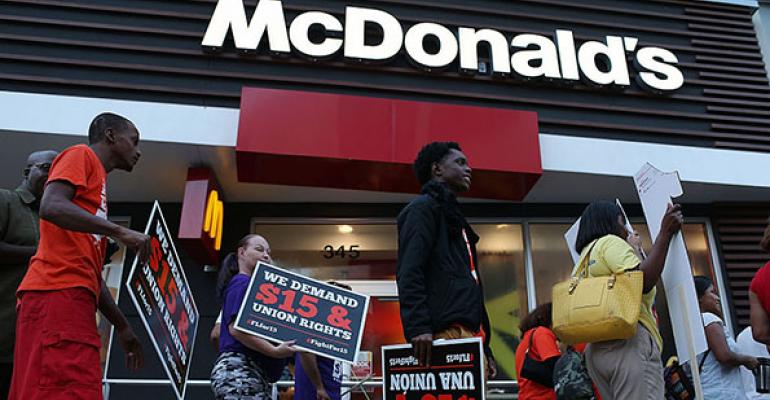Labor activists and union organizers staged protests in more than 300 cities across the country beginning in the early morning hours on Thursday in a growing fight to increase wages to $15 an hour.
“Fight for $15” organizers, led by the Service Employees International Union, organized what has become an annual push to raise wages and unionize restaurant workers.
The group has concentrated mainly on McDonald’s restaurants in cities across the country. But protesters also disrupted a breakfast hosted by the Minnesota Retailers Association on Thursday.
Protesters frequently started in the morning at one location before moving to other locations. Activists protested in New York’s Times Square and in Chicago, and shut down a McDonald’s restaurant in Orlando, Fla. Protests have also spread to other countries, such as Estonia, Brazil and Russia.
The effort comes amid a continued debate over the push for higher wages. Advocates for the restaurant industry, preparing for a day full of protests, ran a full-page ad on Thursday in USA Today showing a McDonald’s customer ordering from a kiosk.
“Labor unions protesting for a $15 starter wage should be careful what they wish for,” the ad says. “When customers reject higher prices, entry-level jobs are automated.”
McDonald’s did not respond to a request for comment by press time.
The SEIU and labor activists have been pushing for higher wages for years, focusing particularly on McDonald’s and other quick-service chains. They have had some success: last year, McDonald’s increased starting wages at company-owned restaurants by $1 an hour above a local area’s minimum wage. Executives have said that the higher wage has helped McDonald’s attract workers and keep them longer.
New York and California, meanwhile, recently approved landmark agreements to raise their states’ minimum wages to $15 an hour, joining a number of local areas that have already done so.
A $15 an hour minimum wage is more than twice the federal minimum wage of $7.25, although several states have made moves to increase their rates to $9 an hour or more.
Labor activists and, increasingly, politicians say the increase is necessary to enable more of these workers to raise families. A growing number of minimum wage workers are adults who run households. More than 40 percent of the 3 million workers paid at or below the minimum wage are 25 or older, according to federal data.
The restaurant industry is particularly sensitive to the minimum wage because it hires large numbers of entry-level, low-skilled workers. On average, restaurants spend 25 percent to 33 percent of revenue on labor. In recent years, operators have been hiring at a breakneck pace.
The industry worries that higher labor costs associated with a $15 starter wage would force them to raise prices dramatically, but that consumers would be unlikely to pay those prices, particularly at places like McDonald’s, where customers care deeply about value.
Some industry members also contend that the protests and the push for higher wages are masking the real intent of the effort: To unionize the restaurant industry.
Contact Jonathan Maze at [email protected]
Follow him on Twitter: @jonathanmaze





